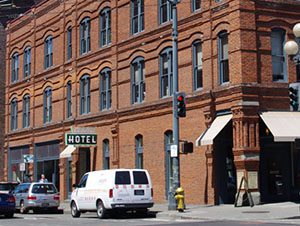 Reflecting on seismic activity in 2023, nine deadly and damaging earthquakes occurred globally. In February, Turkey and Syria experienced two earthquakes over magnitude 7.5 that killed over 59 thousand people. In September, Morocco experienced a magnitude 6.8 earthquake that killed almost three thousand people. In October, Afghanistan experienced a magnitude 6.3 earthquake that killed over one thousand people. In November, Nepal experienced a magnitude 5.7 earthquake that killed over 150 people. In December, China experienced a magnitude 5.9 earthquake that killed 149 people. Four additional earthquakes in Afghanistan, Ecuador, Turkey, and the Philippines each resulted in deaths of ten or more people. While earthquakes cannot be predicted, we know Seattle will experience a damaging earthquake in the future and we can predict how buildings will perform in an earthquake. 2023 was a year of progress and milestones in advancing the seismic resilience of Seattle’s unreinforced masonry (URM) buildings, buildings that are prone to collapse in an earthquake. In the past year:
Reflecting on seismic activity in 2023, nine deadly and damaging earthquakes occurred globally. In February, Turkey and Syria experienced two earthquakes over magnitude 7.5 that killed over 59 thousand people. In September, Morocco experienced a magnitude 6.8 earthquake that killed almost three thousand people. In October, Afghanistan experienced a magnitude 6.3 earthquake that killed over one thousand people. In November, Nepal experienced a magnitude 5.7 earthquake that killed over 150 people. In December, China experienced a magnitude 5.9 earthquake that killed 149 people. Four additional earthquakes in Afghanistan, Ecuador, Turkey, and the Philippines each resulted in deaths of ten or more people. While earthquakes cannot be predicted, we know Seattle will experience a damaging earthquake in the future and we can predict how buildings will perform in an earthquake. 2023 was a year of progress and milestones in advancing the seismic resilience of Seattle’s unreinforced masonry (URM) buildings, buildings that are prone to collapse in an earthquake. In the past year:
- The URM Retrofit Technical Standard was updated and SDCI hosted webinars to educate stakeholders. Webinar recordings and slides are available on SDCI’s Unreinforced Masonry Buildings project documents page. The Standard establishes two pathways for URM retrofits, the code-based method or the Alternate Method that is similar to California’s “Bolts+” method.
- Director’s Rule 6-2023, A Method for the Seismic Improvement of Unreinforced Masonry Buildings, was adopted which allows for the voluntary use of the Alternate Method for qualifying structures undergoing seismic retrofit.
- Resolution 32111 was adopted which directs SDCI to create a voluntary URM Retrofit Ordinance using the URM Retrofit Technical Standard. Buildings retrofitted to either method described in the Standard will not be subject to future mandatory seismic retrofitting legislation adopted by the Council and the Mayor.
- Congresswoman Pramila Jayapal met with representatives of City and key stakeholders to discuss opportunities to increase access to federal funding for earthquake retrofit projects.
- The City met with the advisory council to the Federal Emergency Management Agency (FEMA) to discuss the challenges associated with accessing FEMA grant funds for earthquake risk reduction projects. As a result of this meeting, formal recommendations were made by the advisory council to increase federal funding for earthquake retrofits and to reduce barriers for seismic projects associated with FEMA grant scoring criterion.
- SDCI established a series of policy development working groups to inform funding, communications, and resource development needs of URM building owners and tenants. These groups met a collective total of ten times.
- SDCI is working in partnership with the Office of Emergency Management to develop and submit a FEMA grant application in support of URM retrofits to the WA Emergency Management Division.
The above progress would not have been possible without the collaboration of the volunteer-based URM Technical Standard Team and the Structural Engineers Association of Washington (SEAW) who helped update the URM Retrofit Technical Standard; the Alliance for Safety, Affordability, and Preservation (ASAP!) who have supported innovative funding strategies and retrofit case studies to inform development of Seattle’s URM retrofit program; and community stakeholder groups like the Chong Wa Benevolent Association, Seattle Chinatown International District Preservation and Development Authority (SCIDpda), InterimCDA, Historic South Downtown, the Alliance for Pioneer Square, Historic Seattle, and others for providing input specific to preserving local values and ensuring Seattle’s URM retrofit program is designed to meet the unique needs of these culturally rich neighborhoods. Finally, progress toward URM retrofit legislation would not have been possible without the leadership of Councilmember Lisa Herbold who worked with the Mayor’s Office for the joint passage of Resolution 32033 in 2021, which guided the City’s development of a URM retrofit program, and the adoption of Resolution 32011 that paves a pathway for a future voluntary URM retrofit ordinance.
Looking ahead to 2024, the URM team intends to make continued progress in improving Seattle’s seismic safety. The team’s primary goal for the year is to develop and adopt a voluntary URM retrofit ordinance informed by the recently updated URM Retrofit Technical Standard. Additional goals include further exploration and development of funding options in support of a future mandatory retrofit ordinance. SDCI is planning a meeting for URM owners and developers in late February to discuss a development of a new transfer of development rights program that would allow owners of URM retrofits to sell development rights to support funding their URM retrofit work. Details for this meeting will be posted to SDCI’s Unreinforced Masonry Buildings webpage. Additionally, Seattle will be hosting the 2024 Annual Meeting of the Earthquake Engineering Research Institute (EERI) the week of April 9-12. This meeting of engineers, geologists, social scientists, and emergency managers will be focused on creating an earthquake resilient future and will include presentations on Seattle’s URM Retrofit Technical Standard and retrofit funding strategies. Visit the EERI events webpage for more information about the EERI 2024 Annual Meeting and how to register.